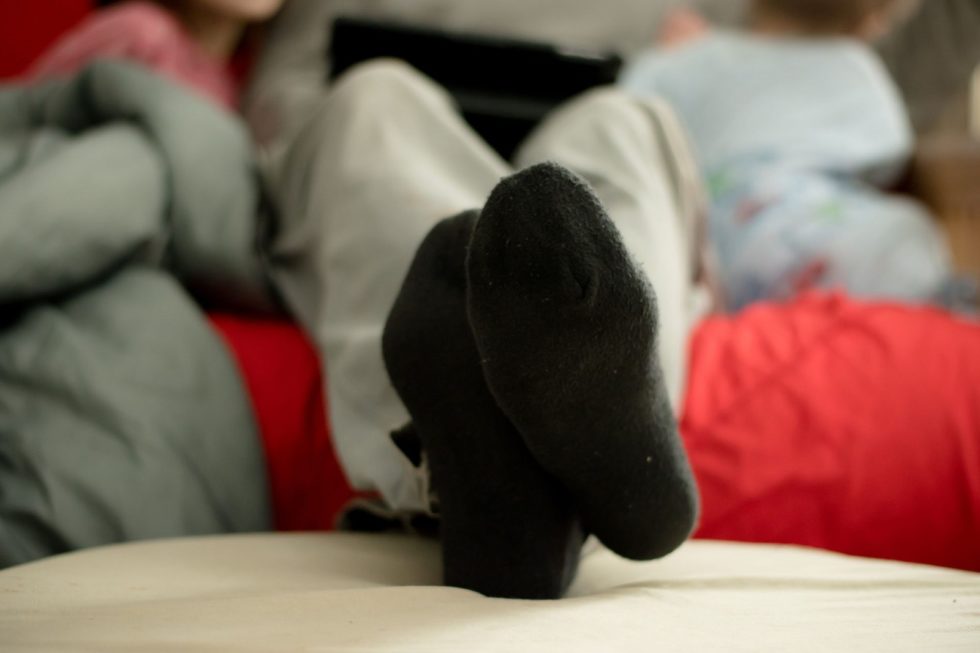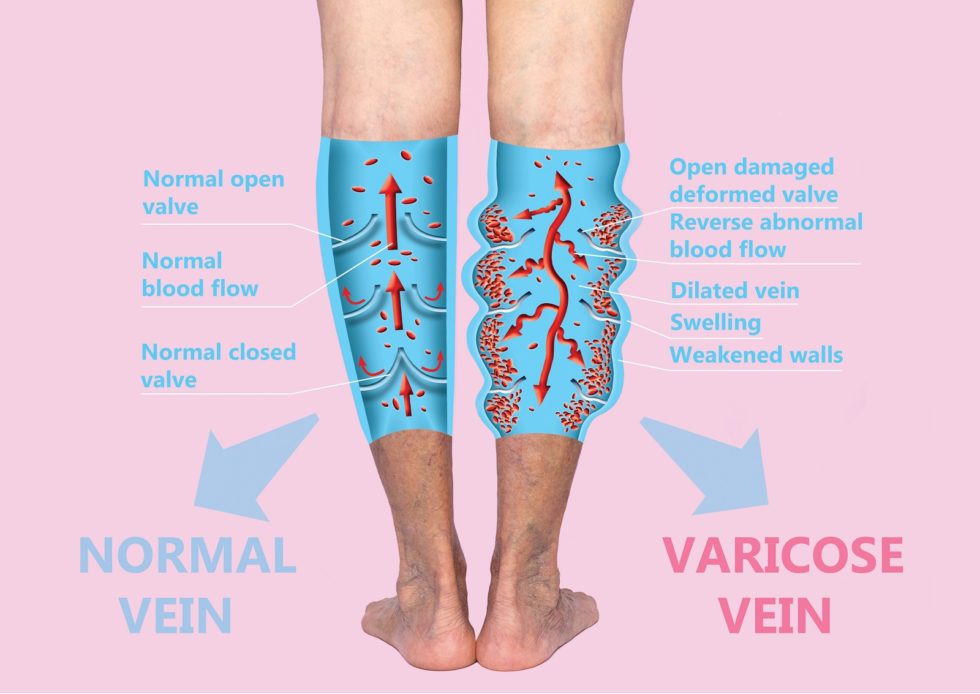The Benefits to Elevating Legs is Real! Here Are a Few You May Not Know
Author: StrideCare Internal Team

As a construction foreman, Chris* spends a lot of time on his feet. He constantly complains about how much his legs and feet hurt. Naturally, the first thing he does every night when he gets home is kick off his shoes, ease back in his favorite recliner, prop his feet up under a pillow, and relax. Sound familiar? Of course! Chris isn’t the only one who enjoys kicking back after a long day. But did you know elevating legs has more benefits than just rest?
Putting your feet up and elevating legs has a number of health benefits most of us don’t think about. Even our doctors constantly suggest it because, when done right, this simple act can be a real game-changer when it comes to reducing pain and swelling—especially for those whose leg and feet pain are the result of underlying vein disease.
Why Does My Doctor Tell Me to Elevate My Legs?
You could be like Chris and simply need to rest your tired dogs for a few minutes each night. But it’s no secret that other people experience pain in their legs and feet for entirely different reasons—possibly because of an underlying vascular issue. An average of one in every three adults over the age of 45 develops some form of vein disease. But truth be told, age isn’t a defining factor—it can also affect seemingly healthy men and women in their 20s and 30s. This is because our veins can also be affected by life choices such as diet, excess weight, smoking, heredity, excessive standing, pregnancy, hormones, and a sedentary lifestyle.
In healthy veins, our veins and arteries work together to pump blood seamlessly throughout our bodies, and one-way valves close so that blood cannot leak down the legs. As we get older, those same valves get weaker and don’t close all the way. As a result, our veins swell as they fill up with blood.

At first, this condition may be painless. Eventually, occasional achiness, throbbing, and numbness sets in and slowly gets worse as you experience any of the following symptoms:
- Unexplained leg swelling in your feet and ankles
- Visible spider veins or varicose veins
- A feeling of heaviness in the legs
- Muscle cramps
- Discomfort when sitting or standing for a long time
- Cold or numb legs
- Skin color and texture changes on legs and feet
Studies consistently show that elevating legs for 30 minutes at least four times a day can decompress lower extremity veins and improve symptoms.
Here’s why: one of the first things people with leg pain and vein issues will do is sit down with their legs on the floor, thinking that this is good enough to improve their symptoms. But as soon as they stand up, the pain returns—almost worse than before.
This is because your veins are still working hard to pump blood back to your heart even while sitting. Elevating legs uses gravity to your advantage by allowing blood that has pooled in your extremities to drain away.
4 Steps to Elevating Legs Correctly
- Recline or lie down in a comfortable position
- Prop your legs up so that they are above heart level
- If necessary, use a pillow to achieve the correct height
- Keep your legs elevated and repeat 3 to 4 times each day
As you constantly stand or sit all day, you’ll likely notice swelling and pressure throughout the day. Elevating your legs takes that pressure off and gives your legs and feet a chance to be less swollen.
What Are the Benefits of Elevating Legs?
- Reduces swelling
As you constantly stand or sit all day, you’ll likely notice swelling and pressure throughout the day as your extremities accumulate excess fluid and inflammation. Elevating your legs takes that pressure off and reduces swelling by allowing excess fluid to drain away.
- Improves blood flow
Your veins require help from tiny valves and surrounding muscles to move blood back and forth to your heart. When you sit or stand for too long, blood is constantly working against gravity—increasing the likelihood of backflow and blood pooling. By elevating legs, you now have gravity working in your favor.

- Lowers pressure
Just like reducing swelling, elevating legs allows blood that has pooled to drain away. This lowers the pressure on your veins as well, allowing them to benefit from a much-deserved break. Pressure can lead to varicose veins and other more serious vein issues if left unchecked.
- Improves vein disease symptoms
The signs of vein disease are numerous. At first, it could be a few unsightly spider veins and varicose veins. Perhaps none are painful at the moment. But over time, these issues can lead to more serious complications and conditions, including but not limited to:
Varicose Veins: Characterized by dark blue bulges that stick out from the skin like raised tunnels. Some people don’t experience any painful symptoms, but for others, they can lead to serious and worsening medical issues.
Restless Leg Syndrome: This itchy, prickling, pulling or crawling sensation in the legs affects 5-10% of adults in the U.S., and studies indicate that as many as 22% of those with RLS also have venous insufficiency.
Chronic Venous Insufficiency: This condition occurs when you don’t have proper blood flowing from the veins in your legs back up to your heart. Instead, blood flows backward and pools in your legs.
Lymphedema: A condition in which the lymph nodes in your body are not draining excess fluids from your tissues. As a result, leg swelling and edema can occur.
Phlebitis: With this condition, the vein becomes inflamed because there’s blood clotting inside it or the vein walls are damaged. The inflammation may cause pain and swelling when surrounding tissues become irritated.
Deep Vein Thrombosis (DVT): A life-threatening condition where blood clots form in one of the veins deep within your body. Patients experience swelling in the legs and feet, foot pain, leg pain, and burning sensations.
Like anything else, there are always precautions to be aware of with elevating legs. In rare situations, it’s possible that elevating legs may not be a recommended practice. If you have underlying vein conditions like the ones above or any other health issues, it is wise to talk with your doctor to ensure elevating your legs is safe for you. If your doctor prescribes elevating legs, that may include specific tips to benefit your unique situation.
Find the Experts You Can Trust at StrideCare
While elevating your feet is a common practice for many people that doesn’t require medical intervention, it is not a cure-all fix. By treating underlying causes of swollen feet or foot pain—which can be due to vascular diseases—we help our patients achieve a new lease on life.
StrideCare is here to help you. Our expert doctors and caring staff utilize the latest technologies and minimally invasive procedures to help our patients with a variety of vein and artery diseases.
The vascular physicians at StrideCare are board-certified diagnostic radiologists with additional fellowship training in vascular and interventional radiology. They are highly rated by patients as indicated by the many 5-star reviews.
Request an appointment for a vein disease evaluation to discuss your options.
Prior to starting any new treatment or questions regarding a medical condition, always seek the advice of your doctor or other qualified health provider. This information is not a substitute for professional medical advice.
StrideCare serves the South Texas area including Houston, San Antonio, Austin, Round Rock, Bastrop, Brushy Creek, Cedar Park, Converse, Georgetown, Hutto, Kyle, Leander, Marble Falls, New Braunfels, Pasadena, Pearland, Pflugerville, San Marcos, Schertz, Houston, Sugar Land, Katy, Webster, Bay City, Clear Lake, Lake Jackson, The Woodlands, Universal City, Spring, Kingwood, Stafford, Conroe, Texas City, Cypress, League City, Bellaire, and more.


